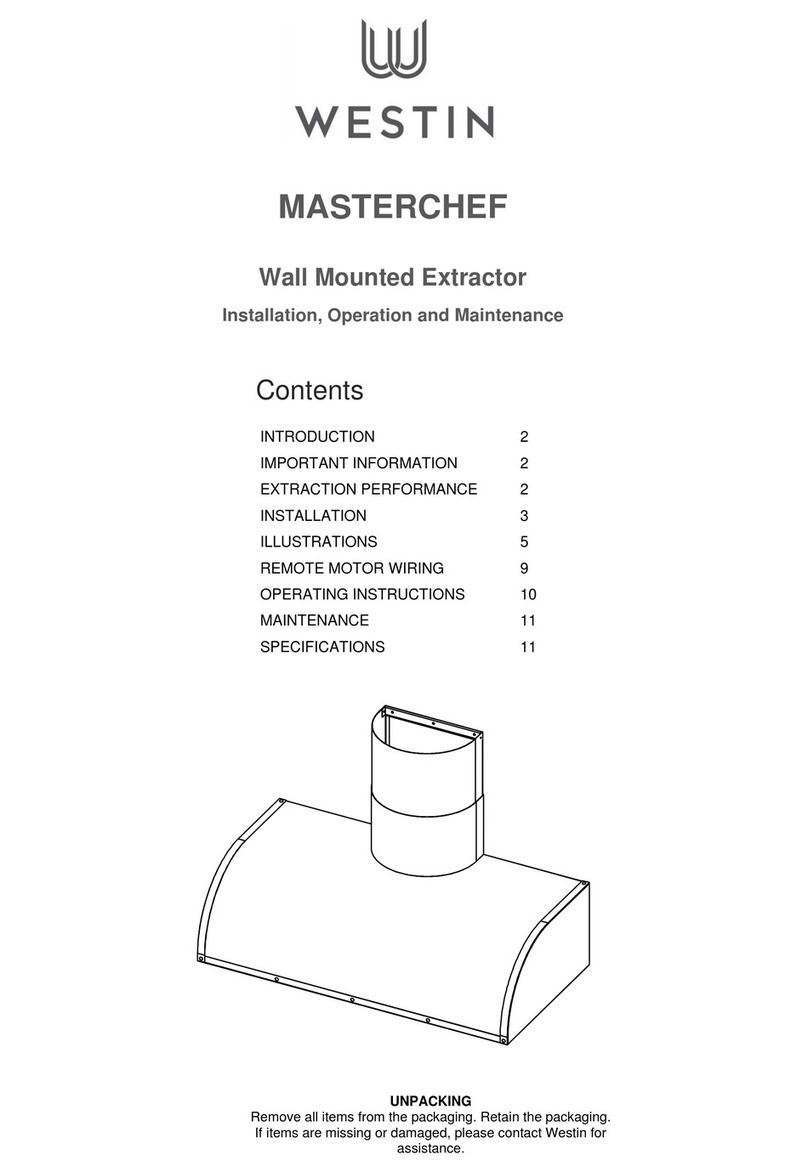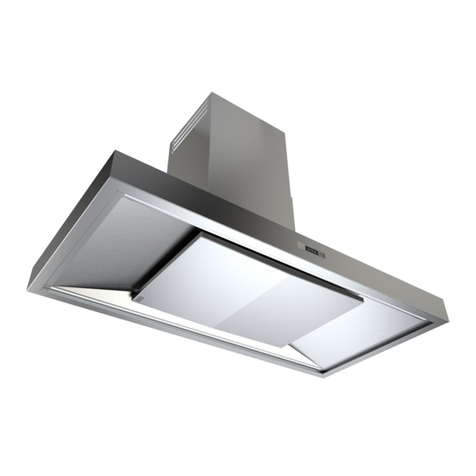
Ceiling Built-in Unit
Installation, Operating & Maintenance Instructions
W1267 WSW STRATUS Ceiling Extract O&M (Energy Label Version) Feb 15.docx Page 2 Westin
1. INTRODUCTION
During the cooking process, there will be heat, vapours and
fumes produced. Your Westin Ceiling Extractor has been
designed to complement your kitchen both in looks and
performance, in order to create a good environment for
creative cooking.
2. IMPORTANT INFORMATION
The exhaust air must not be discharged into a flue which is
used for exhausting fumes from appliances supplied with
energy other than electricity e.g. oil or gas-fired central heating
boilers, gas-fired water heaters, etc.
Requirements of the relevant authorities concerning the
discharge of exhaust air must be complied with.
Pay particular attention to fire risk when frying. To minimise
the risk of fire, all instructions relating to cleaning the grease
filters and removing grease deposits must be adhered to.
Do not flambé under the extractor.
The clearance between the hob burners and the bottom
surface of the extractor must be at least 750mm to prevent
overheating of the extractor and its components.
Please also note that a 90o bend in flexible ducting will require
215mm minimum headroom to give a smooth radius with no
kinking.
You are advised to install measures designed to reduce
the incidence of cold draughts entering the property via
any ductwork.
For extractors with internal or inline motors, this
should, at the very least, consist of an external duct
termination with integrated non-return flaps (e.g.
gravity shutter wall grille/louvre) and/or an inline
backdraught shutter.
For wall-mounted motors, an inline backdraught
shutter is recommended.
3. EXTRACTION PERFORMANCE
As its name suggests, this type of extractor is designed to fit
into the ceiling void, with only the underside and outer flange
visible when installed.
Because fumes spread out as they rise, a unit larger than the
hob area is desirable, although not always possible. The
perimeter extraction system is designed to conceal the grease
filters and to minimise fume escape. Warm cooking fumes that
do escape tend, initially, to accumulate in the highest part of
the room, so situating the unit at the highest point is of benefit.
It will perform best when it is situated directly over the hob.
The primary influence on the overall performance of the
extractor is the design of the ducting which takes the exhaust
air from the extractor to the outside. The duct route should be
a prime consideration during the initial stages of the kitchen
design (Westin do not recommend recirculating air back into
the kitchen).
Please note the following:
Easy access to the duct route during installation is
important. Lack of access may require the “blind” fitting of
flexible ducting (with increased risk of unseen kinks and
impaired efficiency).
The extractor is provided with a spigot suitable for
connecting 150mm diameter ducting.
Note: the cross-sectional area of 150mm diameter duct is
the minimum area consistent with efficient extraction.
The most efficient configuration is to duct straight through
an outside wall, so try to position the cooker against an
outside wall when designing your kitchen.
Your extractor can be set to vent to the rear, front, left or
right. Use the exhaust position which gives the shortest
achievable duct route and least number of bends. Joist
positions will often determine what is achievable.
Rigid 150mm round ducting or an equivalent flat channel
system (available from Westin) will perform best, with
semi-rigid (often referred to as flue liner) being the second-
best solution. Flexible ducting is economical but it’s use
should be minimised as it gives the worst performance and
should only be used for short duct runs (or initial
connection) and should be pulled taut to prevent significant
losses in extraction efficiency.
For maximum efficiency, ducting should be kept as short
as possible and as straight as possible with a constant
cross-sectional area being no less than that recommended
by Westin. Bends in the duct will also degrade
performance so the number of bends in a duct run should
be kept to a minimum and be gradual and smooth to
prevent turbulence. Avoid kinks in flexible ducting; pull
flexible ducting taut over straight runs to ensure that the
internal surface is as smooth as possible.
4. INSTALLATION
The extractor is designed for installation within a cut-out in the
underside of the kitchen ceiling. Alternatively, it may be
installed within a lowered area of ceiling or a soffit panel within
your furniture – remember though that it is desirable to install
directly into the ceiling (see section 3).
Dimensioned drawings and illustrations to help with
your installation can be found on page 7 onwards.
WARNING.
Proper care must be taken to ensure that the negative
pressures caused by high performance extraction
systems do not adversely affect the safe operation of
certain types of fuel-burning appliances (gas, oil or solid
fuel), including those installed in the kitchen and also
those installed in other parts of the house.
Where such fuel-burning appliances are installed,
adequate ventilation MUST be provided in the room of
installation, located and sized such that the negative
pressure in the room created by the extractor does not
exceed 4Pa.
In case of doubt, do not operate the extractor and fuel-
burning appliance(s) simultaneously and consult an
appropriate (for the fuel type) expert for advice.
ELECTRICAL SAFETY.
This appliance requires an earth connection.
Ensure that the supply voltage corresponds to that
marked on the rating label inside the extractor.
The extractor must be isolated from the electrical
supply before carrying out any cleaning or
maintenance operations.



































